Group Presentation: Australian Supermarkets and Grocery Store Analysis
VerifiedAdded on 2023/06/04
|14
|2133
|424
Presentation
AI Summary
This presentation provides an in-depth analysis of the Australian supermarket and grocery store industry, focusing on its growth, key players, and competitive dynamics. The introduction highlights the industry's recent revenue and the major firms: IGA, Coles, Woolworths, and Aldi, as well as the potential entry of Lidl. The presentation examines key external drivers such as consumer sentiment, the increasing demand for takeaway food services, and population growth, and their impact on the industry. It details the current performance and market share of major supermarkets, including the impact of Aldi's entry and the anticipated effects of Lidl. The analysis explores the basis of competition, highlighting the strategies employed by different players, particularly the price wars initiated by Aldi and the responses of Coles and Woolworths. The conclusion summarizes the key findings, emphasizing the market share of Woolworths and Coles, the impact of Aldi, the challenges posed by the rise in takeaway food demand, and the potential effects of Lidl's entry. The presentation references relevant academic sources to support its claims and provides a comprehensive overview of the industry's current state and future prospects.

SUPERMARKETS AND GROCERY
STORES IN AUSTRALIA
PRESENTATION
STORES IN AUSTRALIA
PRESENTATION
Paraphrase This Document
Need a fresh take? Get an instant paraphrase of this document with our AI Paraphraser

Introduction
The supermarket and grocery industry in Australia has grown over the past five years
with a recent annual revenue of 102.3 billion dollars in the 2017-2018 financial year.
This growth and development has been contributed to the growth in demand for grocery
products by consumers in the industry. IGA, Coles, Woolworths, and Aldi are the major
firms in the market whose rivalry has ensured an increase in quality goods are low and
affordable prices. It is expected that Lidl the sister to Aldi may enter the market
probably before the end of the 2018-2019 financial year however possible scenarios
outcomes will be discussed in this presentation to depict a clear perspective of the
outcomes and effects it will have in the overall industry
The supermarket and grocery industry in Australia has grown over the past five years
with a recent annual revenue of 102.3 billion dollars in the 2017-2018 financial year.
This growth and development has been contributed to the growth in demand for grocery
products by consumers in the industry. IGA, Coles, Woolworths, and Aldi are the major
firms in the market whose rivalry has ensured an increase in quality goods are low and
affordable prices. It is expected that Lidl the sister to Aldi may enter the market
probably before the end of the 2018-2019 financial year however possible scenarios
outcomes will be discussed in this presentation to depict a clear perspective of the
outcomes and effects it will have in the overall industry

A)The Key External Drivers
Consumer sentiment index- Through a financial perspective, consumers are able to generally
perceive the current state of an economy in the country. The consumption of products is
generally higher when the consumer sentiment is high. The next slide illustrates the current
consumer sentiment index in the country this year. The consumer sentiment jumped at its highest
levels in July due to propelled by stronger confidence levels towards the economic outlook such
as the tax cuts by the federal government which increased consumer buying power in the
supermarket and grocery industry. However the consumer sentiments tumbled three point in
September but significantly recovered by a point due to the increase in household budget
pressure and mortgage rates interest which has which has depicted family finances to be
noticeably weaker which has led to consumers adopting a decidedly risk-averse stance about
their finances and preferring retailers that offer quality goods at low prices such as Aldi
Consumer sentiment index- Through a financial perspective, consumers are able to generally
perceive the current state of an economy in the country. The consumption of products is
generally higher when the consumer sentiment is high. The next slide illustrates the current
consumer sentiment index in the country this year. The consumer sentiment jumped at its highest
levels in July due to propelled by stronger confidence levels towards the economic outlook such
as the tax cuts by the federal government which increased consumer buying power in the
supermarket and grocery industry. However the consumer sentiments tumbled three point in
September but significantly recovered by a point due to the increase in household budget
pressure and mortgage rates interest which has which has depicted family finances to be
noticeably weaker which has led to consumers adopting a decidedly risk-averse stance about
their finances and preferring retailers that offer quality goods at low prices such as Aldi
⊘ This is a preview!⊘
Do you want full access?
Subscribe today to unlock all pages.

Trusted by 1+ million students worldwide
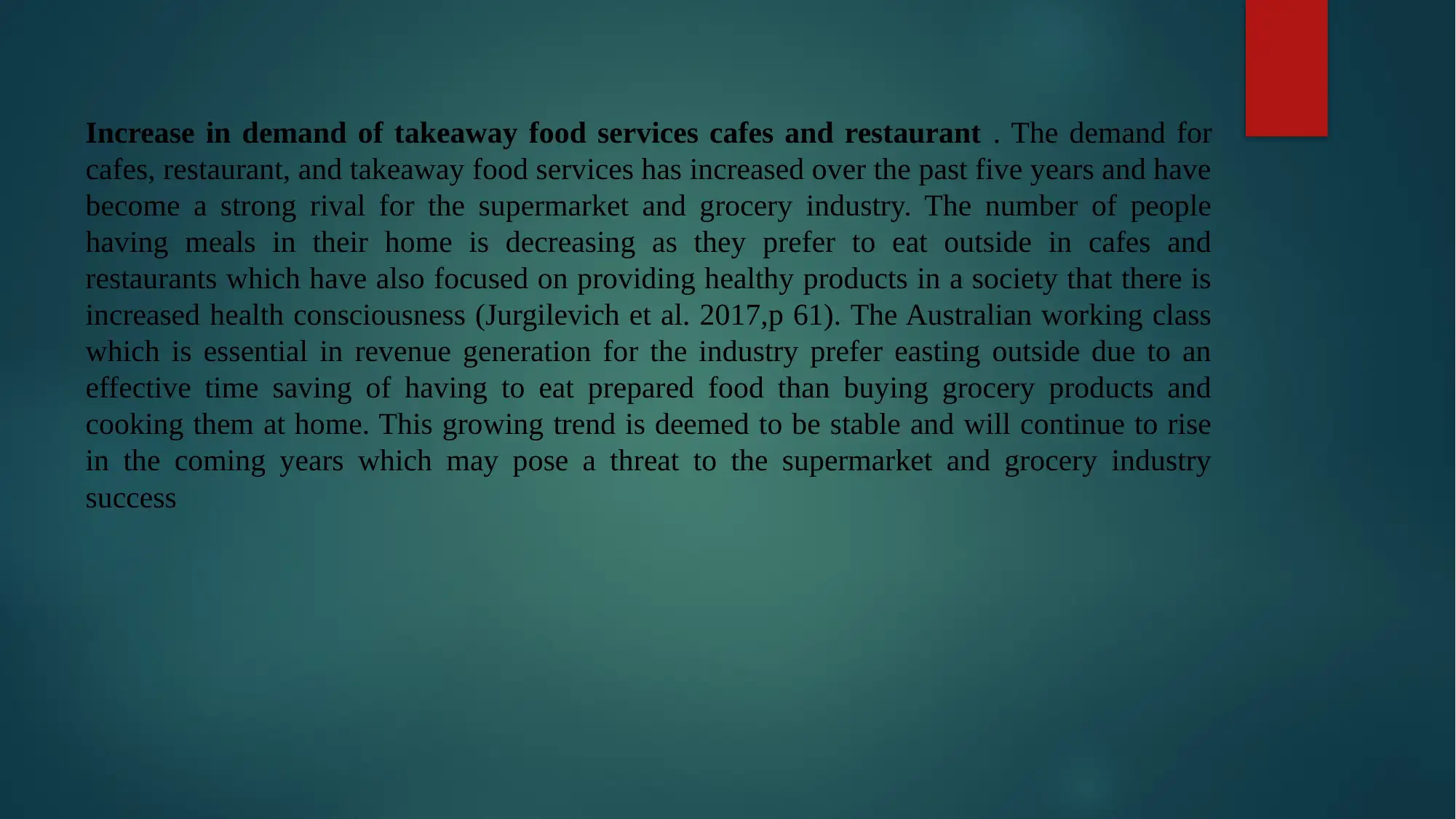
Increase in demand of takeaway food services cafes and restaurant . The demand for
cafes, restaurant, and takeaway food services has increased over the past five years and have
become a strong rival for the supermarket and grocery industry. The number of people
having meals in their home is decreasing as they prefer to eat outside in cafes and
restaurants which have also focused on providing healthy products in a society that there is
increased health consciousness (Jurgilevich et al. 2017,p 61). The Australian working class
which is essential in revenue generation for the industry prefer easting outside due to an
effective time saving of having to eat prepared food than buying grocery products and
cooking them at home. This growing trend is deemed to be stable and will continue to rise
in the coming years which may pose a threat to the supermarket and grocery industry
success
cafes, restaurant, and takeaway food services has increased over the past five years and have
become a strong rival for the supermarket and grocery industry. The number of people
having meals in their home is decreasing as they prefer to eat outside in cafes and
restaurants which have also focused on providing healthy products in a society that there is
increased health consciousness (Jurgilevich et al. 2017,p 61). The Australian working class
which is essential in revenue generation for the industry prefer easting outside due to an
effective time saving of having to eat prepared food than buying grocery products and
cooking them at home. This growing trend is deemed to be stable and will continue to rise
in the coming years which may pose a threat to the supermarket and grocery industry
success
Paraphrase This Document
Need a fresh take? Get an instant paraphrase of this document with our AI Paraphraser
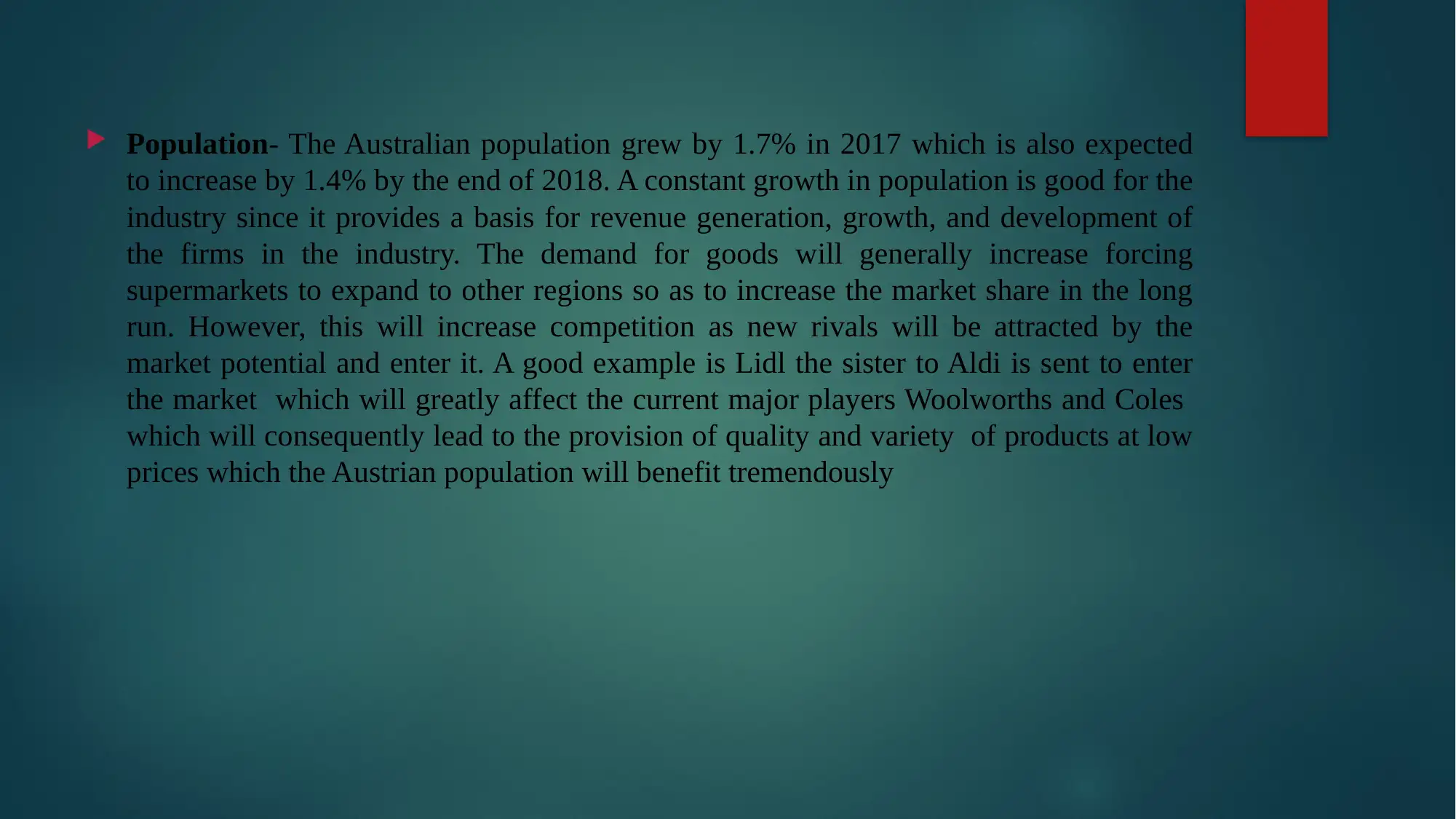
Population- The Australian population grew by 1.7% in 2017 which is also expected
to increase by 1.4% by the end of 2018. A constant growth in population is good for the
industry since it provides a basis for revenue generation, growth, and development of
the firms in the industry. The demand for goods will generally increase forcing
supermarkets to expand to other regions so as to increase the market share in the long
run. However, this will increase competition as new rivals will be attracted by the
market potential and enter it. A good example is Lidl the sister to Aldi is sent to enter
the market which will greatly affect the current major players Woolworths and Coles
which will consequently lead to the provision of quality and variety of products at low
prices which the Austrian population will benefit tremendously
to increase by 1.4% by the end of 2018. A constant growth in population is good for the
industry since it provides a basis for revenue generation, growth, and development of
the firms in the industry. The demand for goods will generally increase forcing
supermarkets to expand to other regions so as to increase the market share in the long
run. However, this will increase competition as new rivals will be attracted by the
market potential and enter it. A good example is Lidl the sister to Aldi is sent to enter
the market which will greatly affect the current major players Woolworths and Coles
which will consequently lead to the provision of quality and variety of products at low
prices which the Austrian population will benefit tremendously
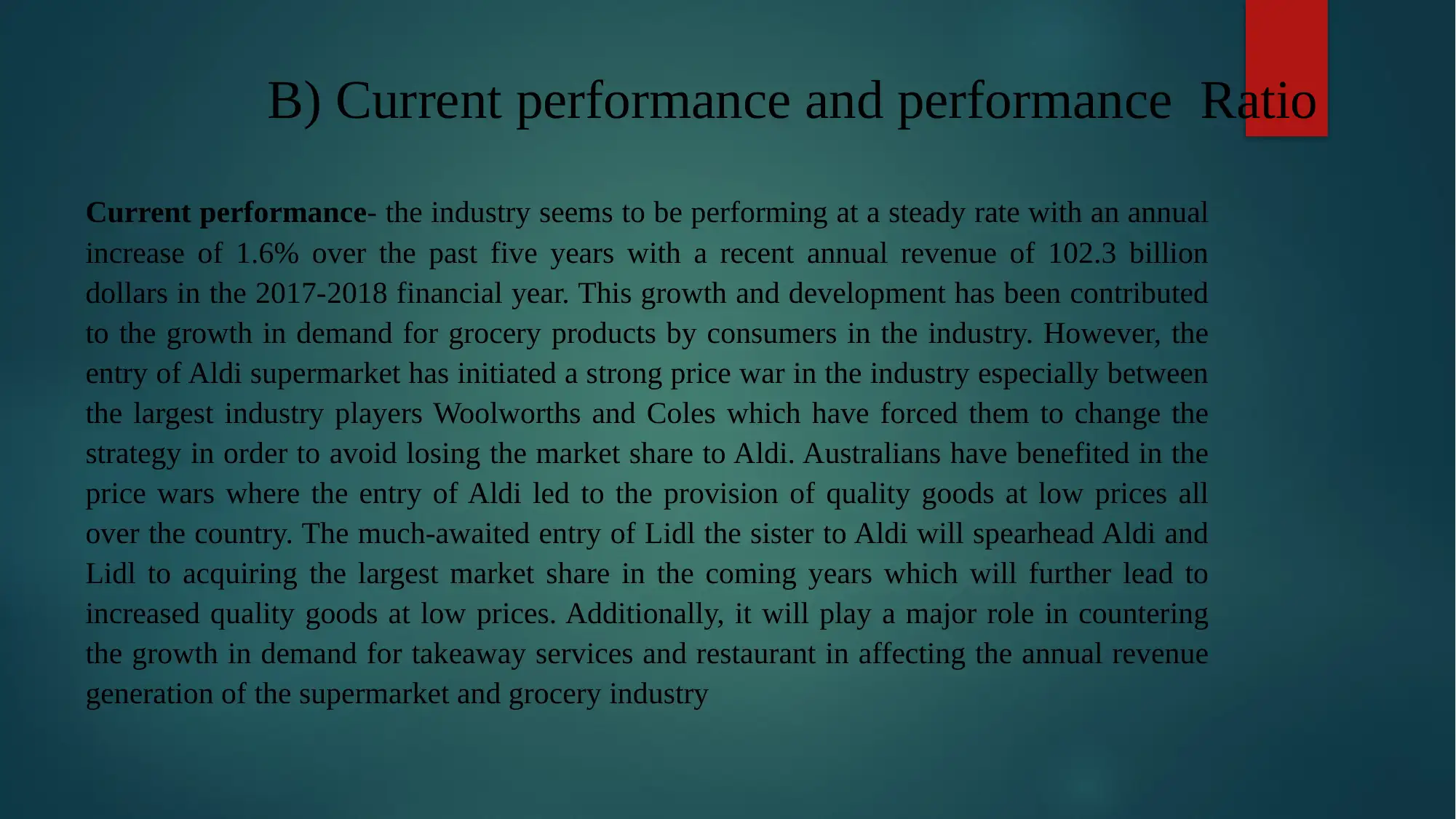
B) Current performance and performance Ratio
Current performance- the industry seems to be performing at a steady rate with an annual
increase of 1.6% over the past five years with a recent annual revenue of 102.3 billion
dollars in the 2017-2018 financial year. This growth and development has been contributed
to the growth in demand for grocery products by consumers in the industry. However, the
entry of Aldi supermarket has initiated a strong price war in the industry especially between
the largest industry players Woolworths and Coles which have forced them to change the
strategy in order to avoid losing the market share to Aldi. Australians have benefited in the
price wars where the entry of Aldi led to the provision of quality goods at low prices all
over the country. The much-awaited entry of Lidl the sister to Aldi will spearhead Aldi and
Lidl to acquiring the largest market share in the coming years which will further lead to
increased quality goods at low prices. Additionally, it will play a major role in countering
the growth in demand for takeaway services and restaurant in affecting the annual revenue
generation of the supermarket and grocery industry
Current performance- the industry seems to be performing at a steady rate with an annual
increase of 1.6% over the past five years with a recent annual revenue of 102.3 billion
dollars in the 2017-2018 financial year. This growth and development has been contributed
to the growth in demand for grocery products by consumers in the industry. However, the
entry of Aldi supermarket has initiated a strong price war in the industry especially between
the largest industry players Woolworths and Coles which have forced them to change the
strategy in order to avoid losing the market share to Aldi. Australians have benefited in the
price wars where the entry of Aldi led to the provision of quality goods at low prices all
over the country. The much-awaited entry of Lidl the sister to Aldi will spearhead Aldi and
Lidl to acquiring the largest market share in the coming years which will further lead to
increased quality goods at low prices. Additionally, it will play a major role in countering
the growth in demand for takeaway services and restaurant in affecting the annual revenue
generation of the supermarket and grocery industry
⊘ This is a preview!⊘
Do you want full access?
Subscribe today to unlock all pages.

Trusted by 1+ million students worldwide
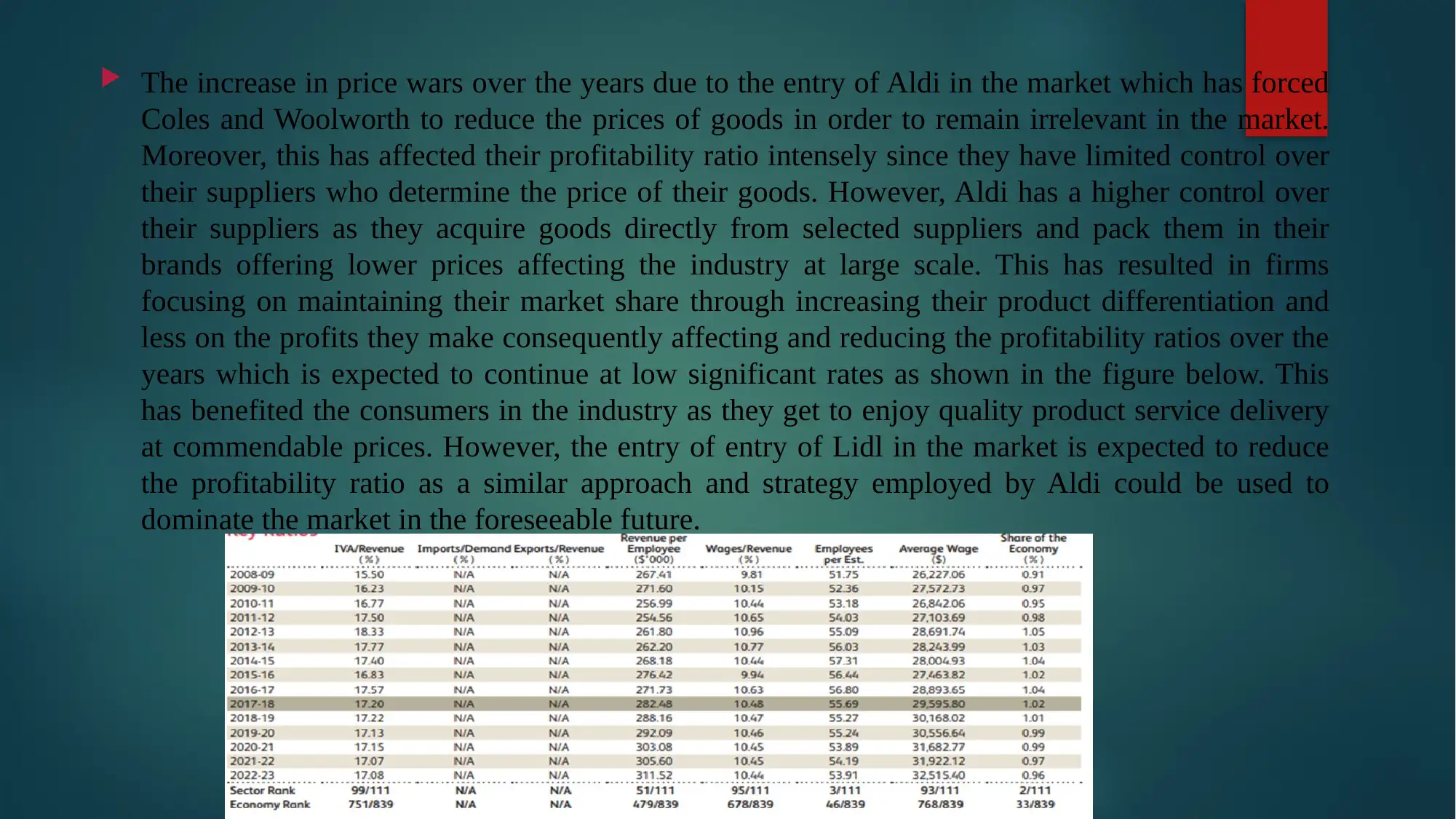
The increase in price wars over the years due to the entry of Aldi in the market which has forced
Coles and Woolworth to reduce the prices of goods in order to remain irrelevant in the market.
Moreover, this has affected their profitability ratio intensely since they have limited control over
their suppliers who determine the price of their goods. However, Aldi has a higher control over
their suppliers as they acquire goods directly from selected suppliers and pack them in their
brands offering lower prices affecting the industry at large scale. This has resulted in firms
focusing on maintaining their market share through increasing their product differentiation and
less on the profits they make consequently affecting and reducing the profitability ratios over the
years which is expected to continue at low significant rates as shown in the figure below. This
has benefited the consumers in the industry as they get to enjoy quality product service delivery
at commendable prices. However, the entry of entry of Lidl in the market is expected to reduce
the profitability ratio as a similar approach and strategy employed by Aldi could be used to
dominate the market in the foreseeable future.
Coles and Woolworth to reduce the prices of goods in order to remain irrelevant in the market.
Moreover, this has affected their profitability ratio intensely since they have limited control over
their suppliers who determine the price of their goods. However, Aldi has a higher control over
their suppliers as they acquire goods directly from selected suppliers and pack them in their
brands offering lower prices affecting the industry at large scale. This has resulted in firms
focusing on maintaining their market share through increasing their product differentiation and
less on the profits they make consequently affecting and reducing the profitability ratios over the
years which is expected to continue at low significant rates as shown in the figure below. This
has benefited the consumers in the industry as they get to enjoy quality product service delivery
at commendable prices. However, the entry of entry of Lidl in the market is expected to reduce
the profitability ratio as a similar approach and strategy employed by Aldi could be used to
dominate the market in the foreseeable future.
Paraphrase This Document
Need a fresh take? Get an instant paraphrase of this document with our AI Paraphraser
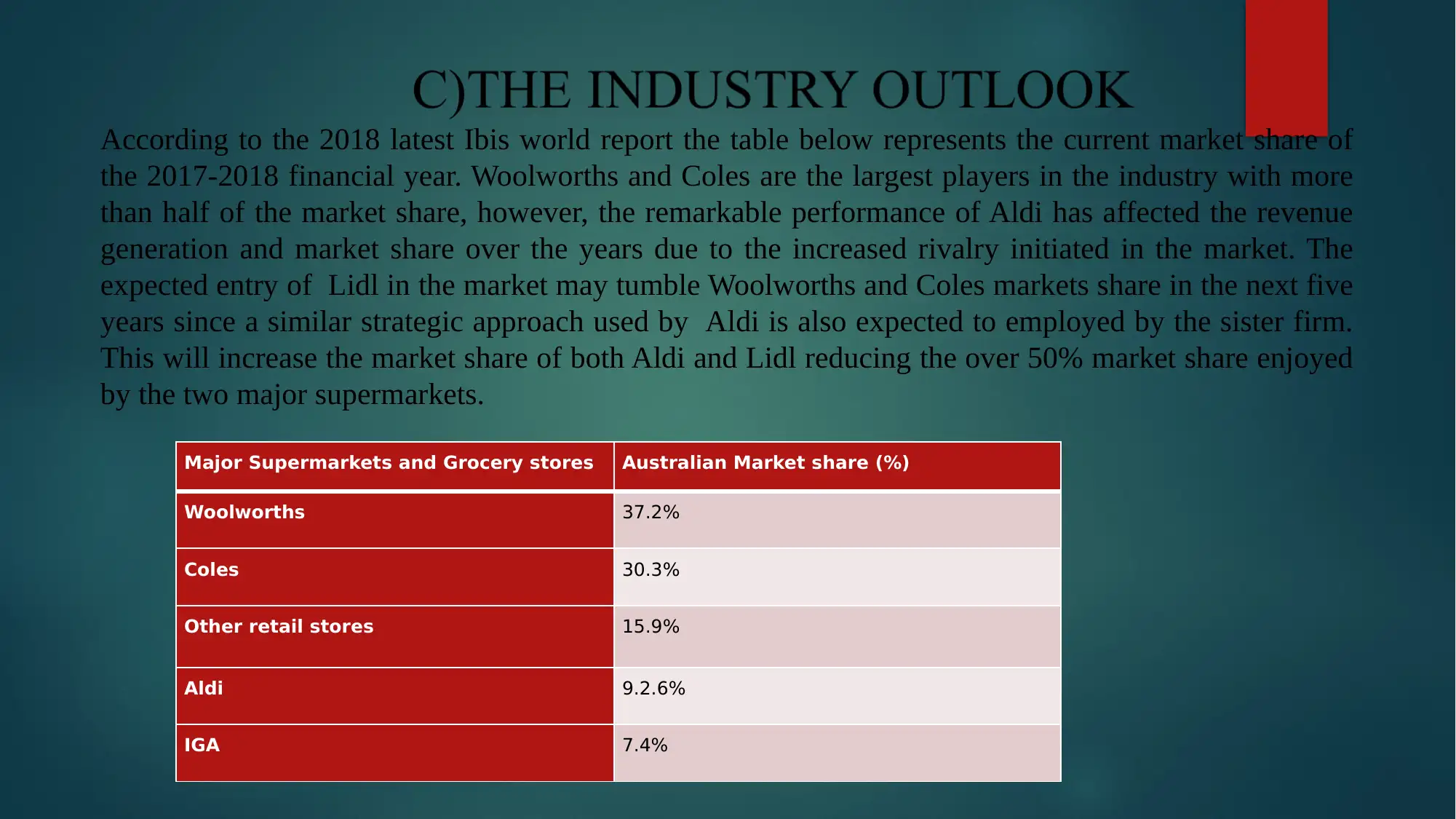
According to the 2018 latest Ibis world report the table below represents the current market share of
the 2017-2018 financial year. Woolworths and Coles are the largest players in the industry with more
than half of the market share, however, the remarkable performance of Aldi has affected the revenue
generation and market share over the years due to the increased rivalry initiated in the market. The
expected entry of Lidl in the market may tumble Woolworths and Coles markets share in the next five
years since a similar strategic approach used by Aldi is also expected to employed by the sister firm.
This will increase the market share of both Aldi and Lidl reducing the over 50% market share enjoyed
by the two major supermarkets.
Major Supermarkets and Grocery stores Australian Market share (%)
Woolworths 37.2%
Coles 30.3%
Other retail stores 15.9%
Aldi 9.2.6%
IGA 7.4%
the 2017-2018 financial year. Woolworths and Coles are the largest players in the industry with more
than half of the market share, however, the remarkable performance of Aldi has affected the revenue
generation and market share over the years due to the increased rivalry initiated in the market. The
expected entry of Lidl in the market may tumble Woolworths and Coles markets share in the next five
years since a similar strategic approach used by Aldi is also expected to employed by the sister firm.
This will increase the market share of both Aldi and Lidl reducing the over 50% market share enjoyed
by the two major supermarkets.
Major Supermarkets and Grocery stores Australian Market share (%)
Woolworths 37.2%
Coles 30.3%
Other retail stores 15.9%
Aldi 9.2.6%
IGA 7.4%

According to IBIS World (2018), The industry has seen an annual growth of 3 % in the last five
years reaching a current annual revenue of 102.3 billion dollars accumulating a profit of 5.4
billion dollars despite the total amount of wages accumulating to 10.7bn dollars. It is expected
that the industry will continue to grow with 1.6% annually in the next five years and possible
2%-2.5% due to the entry of Lidl which is set to increase the annual revenue generation by
providing a limited range of own branded products at extremely low prices which will be
significant in volatile consumer sentiment index due to increase in mortgage rates which have
noticeably depicted the family finances to be noticeably weak and which has led to consumers
adopting a decidedly risk-averse stance about their finances and preferring retailers that offer
quality goods at low prices
years reaching a current annual revenue of 102.3 billion dollars accumulating a profit of 5.4
billion dollars despite the total amount of wages accumulating to 10.7bn dollars. It is expected
that the industry will continue to grow with 1.6% annually in the next five years and possible
2%-2.5% due to the entry of Lidl which is set to increase the annual revenue generation by
providing a limited range of own branded products at extremely low prices which will be
significant in volatile consumer sentiment index due to increase in mortgage rates which have
noticeably depicted the family finances to be noticeably weak and which has led to consumers
adopting a decidedly risk-averse stance about their finances and preferring retailers that offer
quality goods at low prices
⊘ This is a preview!⊘
Do you want full access?
Subscribe today to unlock all pages.

Trusted by 1+ million students worldwide
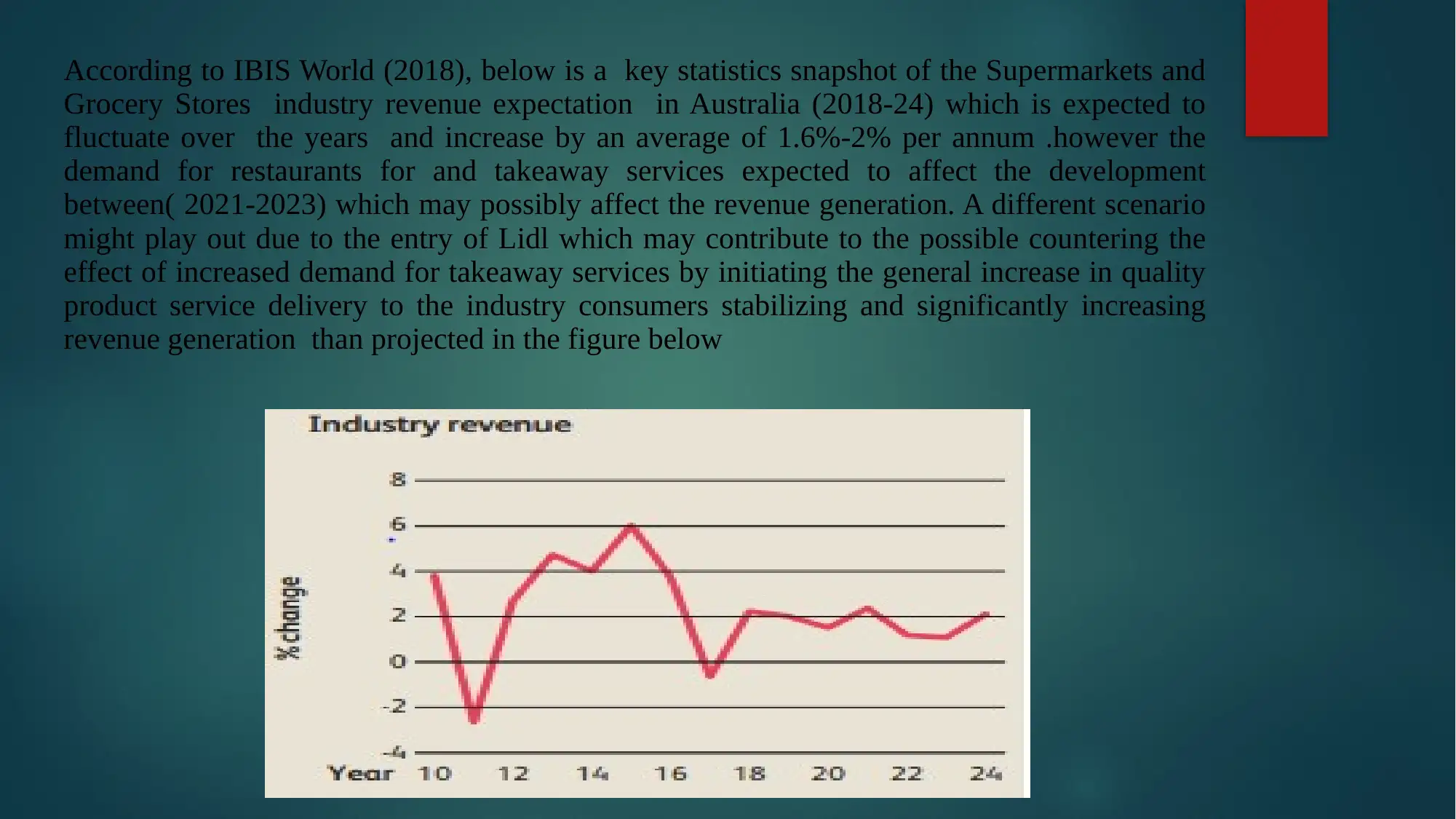
According to IBIS World (2018), below is a key statistics snapshot of the Supermarkets and
Grocery Stores industry revenue expectation in Australia (2018-24) which is expected to
fluctuate over the years and increase by an average of 1.6%-2% per annum .however the
demand for restaurants for and takeaway services expected to affect the development
between( 2021-2023) which may possibly affect the revenue generation. A different scenario
might play out due to the entry of Lidl which may contribute to the possible countering the
effect of increased demand for takeaway services by initiating the general increase in quality
product service delivery to the industry consumers stabilizing and significantly increasing
revenue generation than projected in the figure below
Grocery Stores industry revenue expectation in Australia (2018-24) which is expected to
fluctuate over the years and increase by an average of 1.6%-2% per annum .however the
demand for restaurants for and takeaway services expected to affect the development
between( 2021-2023) which may possibly affect the revenue generation. A different scenario
might play out due to the entry of Lidl which may contribute to the possible countering the
effect of increased demand for takeaway services by initiating the general increase in quality
product service delivery to the industry consumers stabilizing and significantly increasing
revenue generation than projected in the figure below
Paraphrase This Document
Need a fresh take? Get an instant paraphrase of this document with our AI Paraphraser
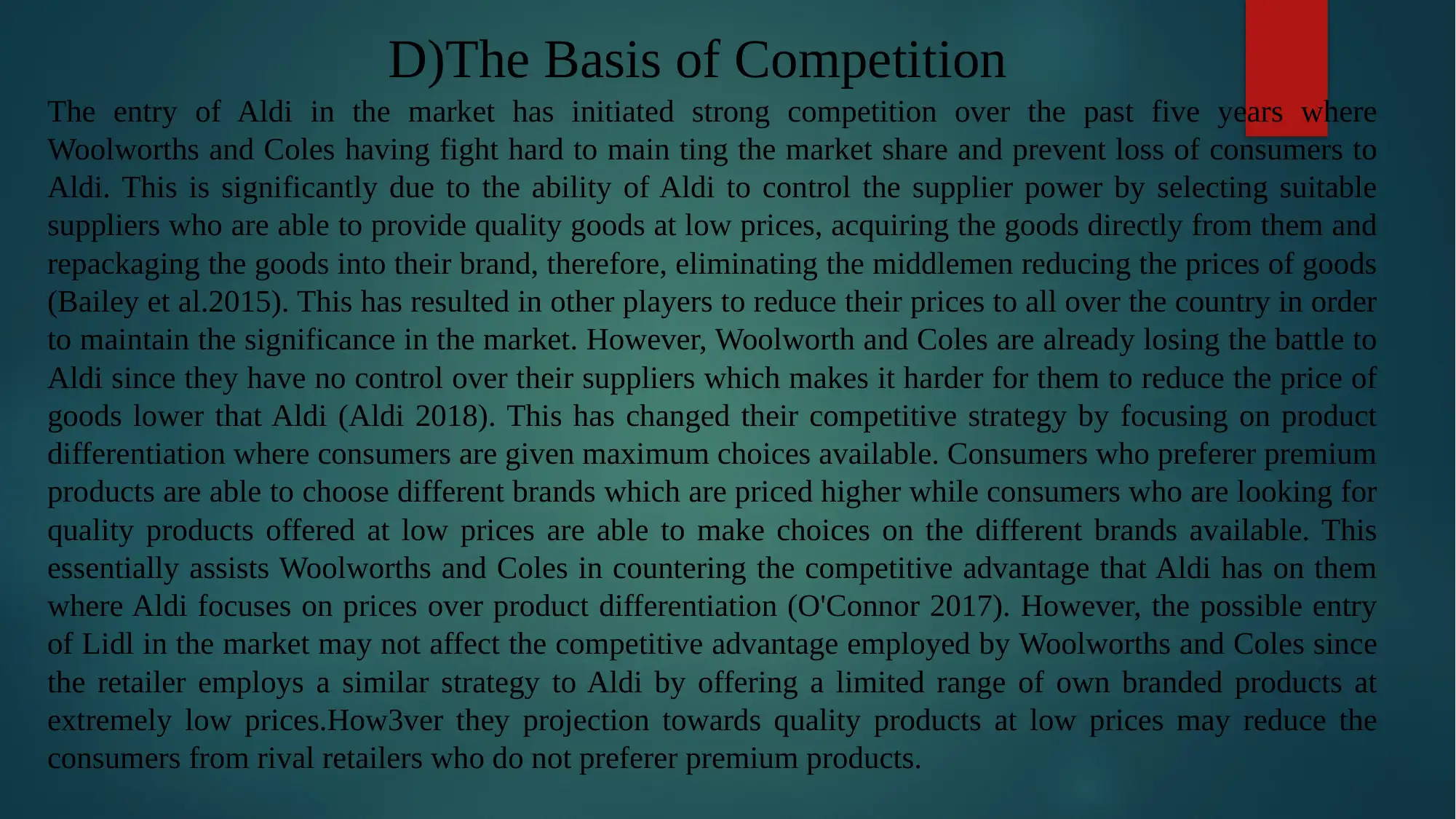
D)The Basis of Competition
The entry of Aldi in the market has initiated strong competition over the past five years where
Woolworths and Coles having fight hard to main ting the market share and prevent loss of consumers to
Aldi. This is significantly due to the ability of Aldi to control the supplier power by selecting suitable
suppliers who are able to provide quality goods at low prices, acquiring the goods directly from them and
repackaging the goods into their brand, therefore, eliminating the middlemen reducing the prices of goods
(Bailey et al.2015). This has resulted in other players to reduce their prices to all over the country in order
to maintain the significance in the market. However, Woolworth and Coles are already losing the battle to
Aldi since they have no control over their suppliers which makes it harder for them to reduce the price of
goods lower that Aldi (Aldi 2018). This has changed their competitive strategy by focusing on product
differentiation where consumers are given maximum choices available. Consumers who preferer premium
products are able to choose different brands which are priced higher while consumers who are looking for
quality products offered at low prices are able to make choices on the different brands available. This
essentially assists Woolworths and Coles in countering the competitive advantage that Aldi has on them
where Aldi focuses on prices over product differentiation (O'Connor 2017). However, the possible entry
of Lidl in the market may not affect the competitive advantage employed by Woolworths and Coles since
the retailer employs a similar strategy to Aldi by offering a limited range of own branded products at
extremely low prices.How3ver they projection towards quality products at low prices may reduce the
consumers from rival retailers who do not preferer premium products.
The entry of Aldi in the market has initiated strong competition over the past five years where
Woolworths and Coles having fight hard to main ting the market share and prevent loss of consumers to
Aldi. This is significantly due to the ability of Aldi to control the supplier power by selecting suitable
suppliers who are able to provide quality goods at low prices, acquiring the goods directly from them and
repackaging the goods into their brand, therefore, eliminating the middlemen reducing the prices of goods
(Bailey et al.2015). This has resulted in other players to reduce their prices to all over the country in order
to maintain the significance in the market. However, Woolworth and Coles are already losing the battle to
Aldi since they have no control over their suppliers which makes it harder for them to reduce the price of
goods lower that Aldi (Aldi 2018). This has changed their competitive strategy by focusing on product
differentiation where consumers are given maximum choices available. Consumers who preferer premium
products are able to choose different brands which are priced higher while consumers who are looking for
quality products offered at low prices are able to make choices on the different brands available. This
essentially assists Woolworths and Coles in countering the competitive advantage that Aldi has on them
where Aldi focuses on prices over product differentiation (O'Connor 2017). However, the possible entry
of Lidl in the market may not affect the competitive advantage employed by Woolworths and Coles since
the retailer employs a similar strategy to Aldi by offering a limited range of own branded products at
extremely low prices.How3ver they projection towards quality products at low prices may reduce the
consumers from rival retailers who do not preferer premium products.
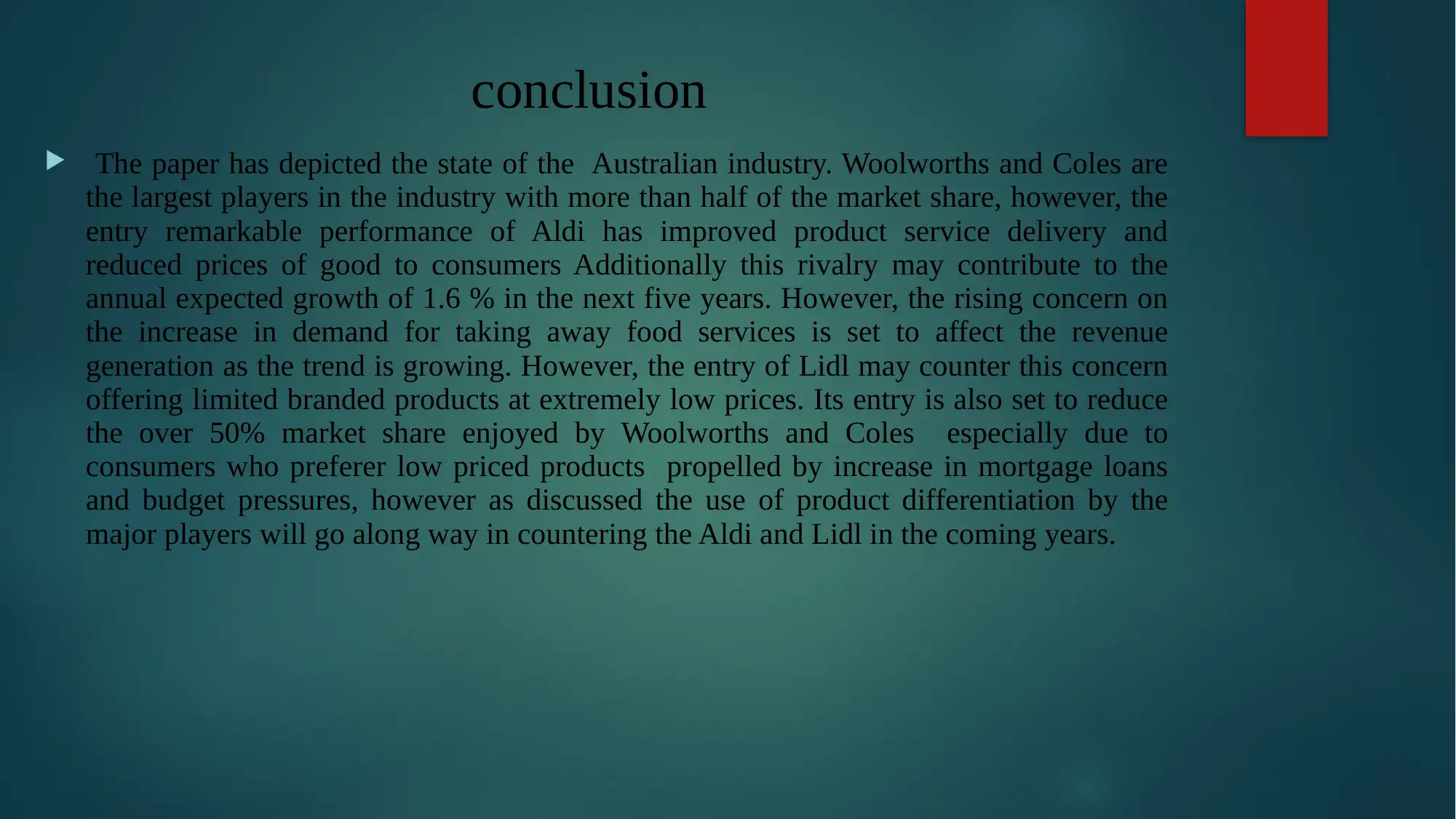
conclusion
The paper has depicted the state of the Australian industry. Woolworths and Coles are
the largest players in the industry with more than half of the market share, however, the
entry remarkable performance of Aldi has improved product service delivery and
reduced prices of good to consumers Additionally this rivalry may contribute to the
annual expected growth of 1.6 % in the next five years. However, the rising concern on
the increase in demand for taking away food services is set to affect the revenue
generation as the trend is growing. However, the entry of Lidl may counter this concern
offering limited branded products at extremely low prices. Its entry is also set to reduce
the over 50% market share enjoyed by Woolworths and Coles especially due to
consumers who preferer low priced products propelled by increase in mortgage loans
and budget pressures, however as discussed the use of product differentiation by the
major players will go along way in countering the Aldi and Lidl in the coming years.
The paper has depicted the state of the Australian industry. Woolworths and Coles are
the largest players in the industry with more than half of the market share, however, the
entry remarkable performance of Aldi has improved product service delivery and
reduced prices of good to consumers Additionally this rivalry may contribute to the
annual expected growth of 1.6 % in the next five years. However, the rising concern on
the increase in demand for taking away food services is set to affect the revenue
generation as the trend is growing. However, the entry of Lidl may counter this concern
offering limited branded products at extremely low prices. Its entry is also set to reduce
the over 50% market share enjoyed by Woolworths and Coles especially due to
consumers who preferer low priced products propelled by increase in mortgage loans
and budget pressures, however as discussed the use of product differentiation by the
major players will go along way in countering the Aldi and Lidl in the coming years.
⊘ This is a preview!⊘
Do you want full access?
Subscribe today to unlock all pages.

Trusted by 1+ million students worldwide
1 out of 14
Related Documents
Your All-in-One AI-Powered Toolkit for Academic Success.
+13062052269
info@desklib.com
Available 24*7 on WhatsApp / Email
![[object Object]](/_next/static/media/star-bottom.7253800d.svg)
Unlock your academic potential
Copyright © 2020–2026 A2Z Services. All Rights Reserved. Developed and managed by ZUCOL.





